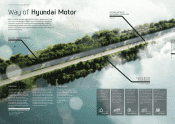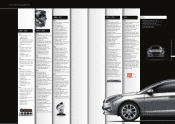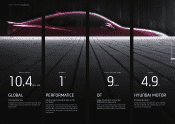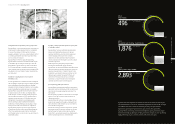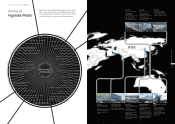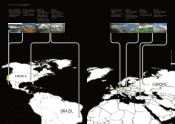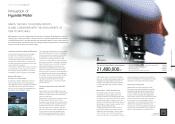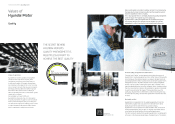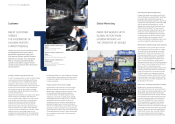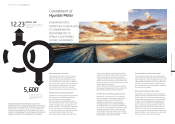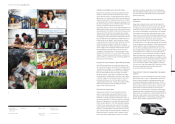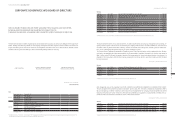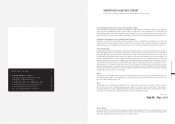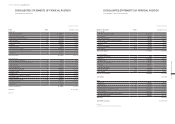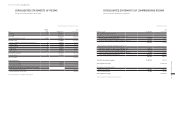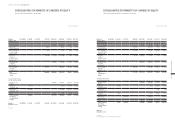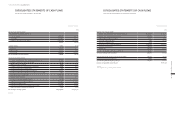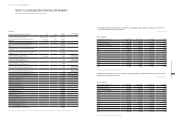Hyundai 2014 Annual Report Download - page 35
Download and view the complete annual report
Please find page 35 of the 2014 Hyundai annual report below. You can navigate through the pages in the report by either clicking on the pages listed below, or by using the keyword search tool below to find specific information within the annual report.
The Asan plant's 10MW rooftop
solar electricity generation system
can reduce up to 5,600 tons of CO
2
emissions per year.
CO2
SOLAR
POWER
5,600t
12.23
million kW
Commitment of
Hyundai Motor
Green technologies for the future
The development of greener vehicles can reduce
greenhouse gas emissions and Hyundai Motor is
developing propriety environmental technologies
with the ultimate goal of zero emissions.
Under the
name of ‘Blue Drive’, Hyundai Motor developed green
technologies which enabled the launch of vehicles
with vastly improved fuel efficiency, innovative
alternative fuel vehicles and clean emission vehicles.
Reducing emissions at manufacturing plants
Hyundai Motor is managing greenhouse gas emissions
from all operation sites including manufacturing
plants, R&D centers and office buildings.
Efforts have been concentrated on the emissions
from three production plants in Korea which account
for 85% of Hyundai Motor’s overall emissions from
domestic operations. At the Ulsan plant, a differential-
pressure power generation facility was installed for
on-site electricity generation. Significant investments
were made to enable the installation of high-
efficiency equipment including low emission boilers.
Thanks to the installation of high-efficiency facilities
and improved productivity, the Asan plant reduced their
greenhouse gas emissions by 8% per unit-produced
compared to the previous year. The Jeonju plant reduced
emissions per unit-produced by 9.1% by investing in high
efficiency equipment, improving production processes and
energy efficiency improvements.
In 2014, a 500kW solar generation plant was installed at
the Namyang Technology Research Center and the staff
improved energy efficiency of testing equipment.
Protecting the environment by recycling resources
Hyundai Motor is promoting resource recycling in all
areas of its operation to strengthen its environmental
management. Hyundai Motor established the first
Automobile Recycling Center in Korea to develop
technologies and processes to minimize the negative
environmental impact from recycling automobiles at the
end of their life cycle. Hyundai Motor decided to support
automobile recycling in Mongolia using its experience
and technological capacity and signed an MOU with the
Mongolia Ministry of Road & Transportation to establish
the Ulaanbaatar ELV Recycling Park (UERP).
Producing clean electricity using solar panels
The Asan plant has a large-scale, solar power plant on its
roof which generates significant amount of clean electricity.
The 10MW generator produces enough electricity to power
3,800 households and reduce CO₂ emission by 5,600 tons per
year, which is equivalent to planting 1.12 million pine trees.
Electricity generated from the solar generator is supplied to
Asan city and near-by regions.
Working with the Emission Trading Scheme
Hyundai Motor has established an internal management
system in response to the implementation of the Emission
Trading Scheme (ETS), a market-based system designed
to deliver greenhouse gas reductions in a growing number
of regions. The Czech Republic plant has already been
operating under the European ETS and Beijing Hyundai
Motor is preparing for the implementation of the ETS in
Beijing, China. The Korean Emission Trading scheme was
launched in 2015 and efforts are ongoing to ensure that
the necessary plants have adequate work processes, work
manual and human resources, organizational capacity and
financial resources to cope with the new policy.
Environmental problems have emerged as a major issue in
determining the future of humanity, Hyundai Motor is dedicated to
minimizing the environmental impact of vehicles throughout their
lifecycle, from development to recycling. Hyundai Motor is also
committed to the development of green energy and is dedicated to
making a contribution to the sustainable future of humanity.
HYUNDAI MOTOR IS
COMMITTED TO FULFILLING
ITS ENVIRONMENTAL
RESPONSIBILITIES TO
ENABLE A SUSTAINABLE
FUTURE FOR MANKIND
HYUNDAI MOTOR COMPANY Annual Report 2014
COMMITMENT OF HYUNDAI MOTOR 68 / 69
Hyundai Motor produced 12.23 million kW
of clean electricity using its rooftop solar
generation system.


